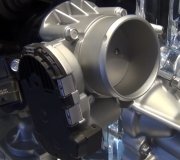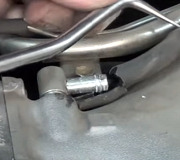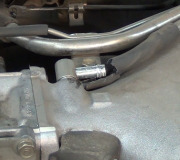AGGGGHHHH! STOP! STOP! STOP before you destroy the car! You are getting some miscommunication from people who understand selling parts. You must never ever disconnect a`battery cable with the engine running, and this is especially true with '87 and newer GM vehicles. Also, they apparently led you to believe you're supposed to unbolt the output wire on the back of the generator. That will stop it from charging, but it's real easy to let the socket or wrench touch that nut and anything metal on the car at the same time. That will give new meaning to fireworks. Go back and read my first reply. The plug is a small one on the side of the generator near the back. There are usually four places in the plug but there may be as little as one brown wire in that plug. Some cars have two wires, but it's very uncommon to find three or four wires. All you have to do is unplug that plug long enough to see if the running problem clears up. If it clears up at idle while you're under the hood, that test will take five to ten seconds and you're done. Sometimes the running problem is only noticed at highway speed. If so, you have to drive at highway speed with the plug disconnected. GM's generators develop huge voltage spikes that can destroy the internal diodes and voltage regulator, and interfere with computer sensor signals. Unplugging the small connector stops it from charging and stops it from developing those voltage spikes. That can potentially stop those spikes from interfering with sensor signals that cause the Engine Computer to do weird things.
You were also misled by the person who scared you that this would allow the battery to run dead. With the generator not working, it is true the engine will be running on just the battery, but you'll get at least a good half hour of driving time, and more if you don't turn on the heater fan, radio, lights, and anything else that uses electricity. If your battery is more than a few years old, you might only get 15 to 20 minutes, but that is still plenty of time to see if the running problem clears up. Once you know that answer, you can pull over on the side of the road, leave the engine running while you reconnect the plug, and the generator will instantly start charging the battery again. At that point you can drive like normal. If you have to drive five miles through the city to get to where the running problem shows up on a highway, just don't disconnect the plug until you get to where the problem typically occurs. Hop out, unplug the connector, drive the car a mile or two, hop out and reconnect the plug. All you need to do is see if the problem acts differently when the generator isn't working. If it does, the generator is the main suspect.
For a more technical answer, here is a copy of a reply I've posted a number of times:
DO NOT DISCONNECT ANY CABLE WITH THE ENGINE RUNNING!
Every year I did a demonstration on the generator test bench for my students to show what can happen when you do that. It was real easy for the voltage to reach over 35 volts. That WILL destroy any computer on the vehicle, the generator's internal diodes and built-in voltage regulator, and any light bulbs that are turned on.
The thinking is that if you disconnect either cable and the engine stays running, the generator must be working but a lot of them will stop working due to the voltage regulator responding to the dips in the "ripple" voltage being produced. That will make a perfectly good generator appear to be bad so that test is not valid.
If a mechanic is caught pulling this stunt he will typically get one verbal warning. For the second offense he will be fired. It's that big a deal.
Some generators respond to the high points in the ripple. That momentary higher voltage goes right back to the field winding and creates a stronger magnetic field. That stronger electromagnet creates a higher output voltage which again creates a stronger electromagnet. It's a vicious circle and voltage can keep on rising until something gives out. The main thing that smoothes out that ripple so it doesn't affect the voltage regulator or the generator is the battery.
Three things are needed to generate the output current. They are a magnet, (electromagnet, in this case), a coil of wire, and most importantly, movement between them. That's why the belt needs to make it spin. One thing that can save you from doing damage by removing a battery cable is not raising engine speed. Generators are relatively inefficient at low engine speeds and their output voltage is less likely to rise to dangerous levels, ... As long as you don't raise engine speed.
One other thing to keep in mind is batteries give off explosive hydrogen gas. Regardless if your generator is working or not there is going to be a big spark when you remove a battery cable with the engine running. Either the generator's current will be recharging the battery, and that can be up to 20 amps, or the battery is going to be supplying the car's electrical systems, and that can easily be over 30 amps. That kind of current is going to create a big spark when a connection is broken or reconnected. Small arc welders run as low as 40 - 60 amps and look at the sparks they create. The reason we don't hear about more battery explosions is because people are careful to not disconnect the cables when there is current flowing through them. It's also why there are huge warning labels on all battery chargers to be sure they are turned off before connecting or disconnecting them from the battery.
Another common generator problem is one defective diode out of the six. You will lose exactly two thirds of the generator's capacity but system voltage will remain normal or it could even be just a little high from the voltage regulator responding to the greatly increased dips in the ripple voltage.
It's always a good idea to wear safety glasses when working around car batteries, but if you still insist on removing a cable while the engine is running, a face shield makes more sense, and have plenty of water on hand to wash any acid off the vehicle's paint.
Ford used to have a really nice generator design that allowed testing right on the back of the unit. Only Chrysler alternators are easier to diagnose. Unfortunately the engineers don't really care about ease of service on GMs and many other brands.
The way you tell if the charging system is working is to measure the battery voltage while the engine is running. It must be between 13.75 and 14.75 volts. There still could be a bad diode though. You need a professional load tester to test for that. Ripple will be very high and the most output current you will get will be one third of the generator's design value. That is not enough to meet the demands of the electrical system under all conditions so the battery will have to make up the difference, until it runs down. You still could have a generator problem. Either have it load-tested or use a home battery charger to fully charge your battery at a slow rate for an hour, then see if it is dead again the next day.
Saturday, October 17th, 2015 AT 8:27 PM




